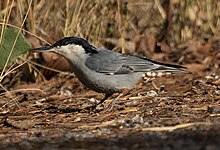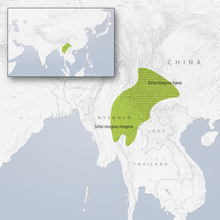
Back البندق العملاق ARZ Гигантска зидарка Bulgarian Pica-soques gegant Catalan Sitta magna CEB Delor cnau mawr Welsh Riesenkleiber German Giganta sito Esperanto Sitta magna Spanish Sitta magna Basque Isonakkeli Finnish
| Giant nuthatch | |
|---|---|

| |
| An individual of the nominal subspecies, Sitta magna magna, on the ground in Thailand. | |
| Scientific classification | |
| Domain: | Eukaryota |
| Kingdom: | Animalia |
| Phylum: | Chordata |
| Class: | Aves |
| Order: | Passeriformes |
| Family: | Sittidae |
| Genus: | Sitta |
| Species: | S. magna
|
| Binomial name | |
| Sitta magna Wardlaw-Ramsay, 1876
| |

| |
| Distribution of the giant nuthatch | |
The giant nuthatch (Sitta magna) is a species of bird in the family Sittidae. It is the largest of the nuthatches, measuring 19.5 cm (7.7 in) in length. Its upperparts are bluish gray, with the front (from crown to upper back) being light gray, contrasting with the darker rest of the back. The bird has two very thick black eyebrow lines and light gray underparts, with whitish cheeks and throat, and a belly more or less washed with buff and cinnamon. For a nuthatch, it has a long beak and tail. The female can be distinguished from the male by its duller eye features and its upperparts having less contrast between the crown, nape, and lower back. The calls are powerful and made up of repetitions of simple patterns. The species gleans its food from the trunks and branches of trees, especially pines, and feeds on insects and berries. It nests around March, in the hole of a tree and without masking the entrance, and the nest has about three young.
The giant nuthatch is distributed from southwest China to east-central Myanmar, northwest Thailand, and probably to the far northwest of Laos. Its altitudinal distribution varies by region, but ranges from around 1000 m up to at least 3,350 m (132,000 in) in China. It forages in pine stands, in particular old Benguet Pines (Pinus kesiya), present on mountain ridges, among the oak-chestnut groves. Two subspecies are distinguished, S. m. magna and S. m. ligea, differing mainly in length and width of the beak. The giant nuthatch is threatened by the destruction of its habitat and is very localized in places. The numbers of the species are difficult to assess and seem to have been overestimated, so in 2013 the International Union for Conservation of Nature changed its status from "vulnerable" to "endangered".
- ^ BirdLife International (2020). "Sitta magna". IUCN Red List of Threatened Species. 2020: e.T22711228A177660236. doi:10.2305/IUCN.UK.2020-3.RLTS.T22711228A177660236.en. Retrieved 12 November 2021.
